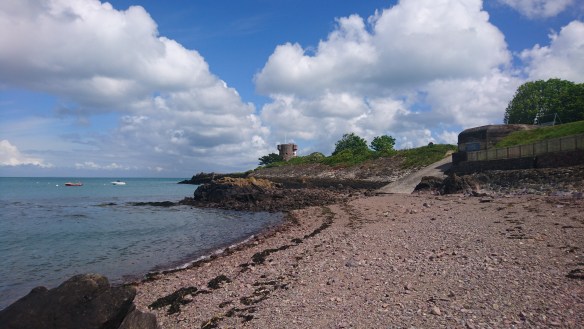By Liz Corry

Archirondel went on a ‘girls’ trip’ to Guernsey at the end of March. Photo by Chris Wilkinson/Facebook.
Channel Island Choughs
The dream finally became a reality this month when two Jersey choughs were photographed in Guernsey. We first discovered the birds had left the island through a post on social media. A post on Guernsey Birdwatching’s Facebook page showed a selection of images and video from a very excited birdwatcher. The images clearly showed the leg rings enabling us to identify Archirondel and Portelet as the two tourists. These are two young, non-breeding females and as such have the freedom to explore.
The last time we recorded Archie and Portelet at the supplemental feed was on 22nd March. After some frantic armchair detective work we discovered that they visited Sark too on 23rd March and were then next seen on the 25th in Guernsey.
The report from Sark is a wonderful description of what it’s like when you spot a chough in flight for the first time:
“I went out to do the mowing at 3.30 pm and thought I heard a jackdaw which we do not usually see in Sark. I looked up and saw a black bird disappearing over towards Derrible Bay (fingers on wings were visible) but it was only a fleeting sighting. A bit later at 4.45 pm when I had finished the mowing I heard the call again and two choughs flew right above me and I realised that it wasn’t a jackdaw but a chough’s call. The red bill of one could be clearly seen but because of the shaded light I could not see whether rings were present on the legs. An altogether more slender bird than the crow and smaller. They turned right and flew down the meadow as if heading off east towards the harbour in a tumbling flight and then veered abruptly and flew off towards the north but heading back towards the east coast.”
The pair stayed in Guernsey over the weekend foraging around Pleinmont near Portelet Bay! Portelet, the chough, returned to Jersey along with Archirondel on Monday the 28th. Quite literally a girls weekend away in the Bailiwick of Guernsey.
We envisaged this could happen when we first planned the reintroduction. It’s not unheard of for UK choughs to spend time foraging on both mainland and a nearby offshore island. This trip might have been a one off, equally it could be the start of a new foraging pattern for Jersey’s choughs.
There is certainly suitable foraging habitat on offer in Guernsey. Pleinmont looks very similar to Les Landes and Grosnez in many respects, but it is too soon to talk breeding opportunities. We need more males for that to happen. No pressure on the breeding pairs then!

Pleinmont in Guernsey appears to provide suitable foraging habitat for choughs. Image from Google Earth.
The 2022 breeding season is underway
March madness came into full force when the breeding choughs began nest building, or nest refreshing for the experienced pairs. Ex-volunteer, Neil Singleton and his wife Ali were treated to an impressive display of ‘flying wool’ when they visited Sorel towards the end of the month. Timed well with the return of the sheep.
I suspect these birds were heading to the quarry although the Plémont pair could have been involved too. They tend to stay local and collect horse hair or wool for Grosnez to Grève de Lecq. It might look like easy cargo, but I have seen a fair few accidentally drop their wool between Sorel and the quarry. Usually when they get distracted by a peregrine or gull or keeper walking below carrying insects!
Plémont sea crows return
Minty and Rey have returned to Plémont to refresh last year’s nest before Rey begins egg laying. The sea crows (to use an old Greek nickname) can often be heard foraging around Plémont headland and seen flying to and fro in search of food. During the nesting season, French choughs are known to spend most of their time within 300 metres of the nest site. If the habitat is suitable, i.e. lots of soil and/or dung invertebrates, the chough pair will be successful.
Minty can afford to spend some time chilling out right now. Once Rey starts incubating, he has the responsibility of finding food for the both of them. Maybe that is why he was happy to do a bit of sunbathing down at Plémont.
The Troublesome Trinity Two
Pinel has returned to Trinity taking his new female, Vicq, with him. They have been visiting the same places as last year such as Peacock Farm and East Ridings Stables. They appear to have chosen to nest in the same building he used the year before with his previous partner. Maybe he sees the potential in the property to become a family home?
Last year the pair abandoned early and weeks later the female disappeared. Hopefully he will have more success this time with Vicq who hatched three chicks in 2021. Sadly, the chicks died before fledging but it shows she can do it.
We are working with the property owner to monitor the situation and see if we need to assist in any way. The owner is very wildlife-friendly which is a big bonus and we have set up a camera-trap in the building, swapping out memory cards on a weekly basis.
Playing in the sand pits
Another chough pair we are keeping an eye on are Danny and Jaune. We had reports of choughs in Simon Sand and Gravel Ltd. down on the west coast. Choughs have also been seen around Corbière this month so the assumption is that they are looking for a suitable nest site but since they are still sub-adults it is doubtful that they will breed this year.



















